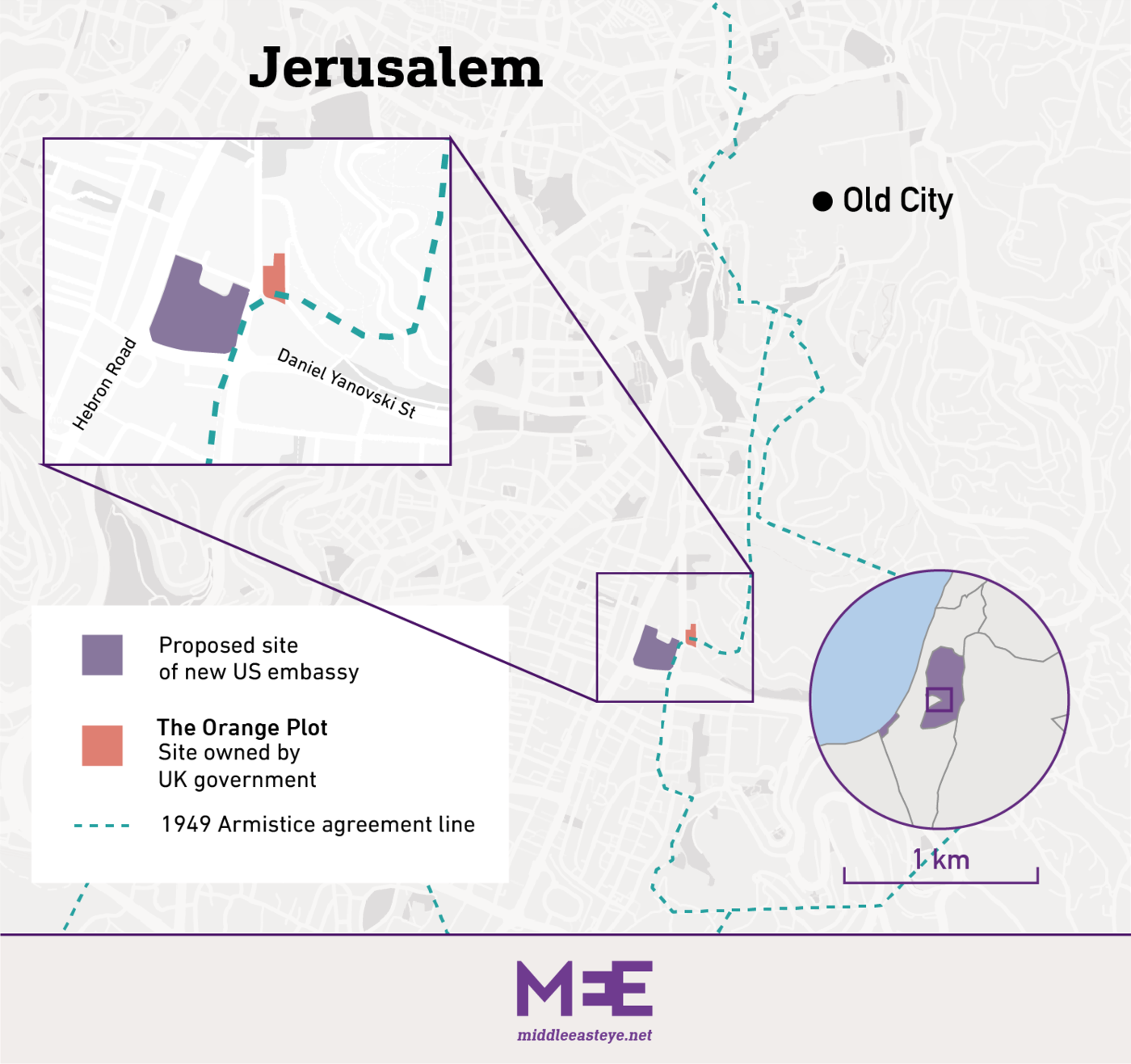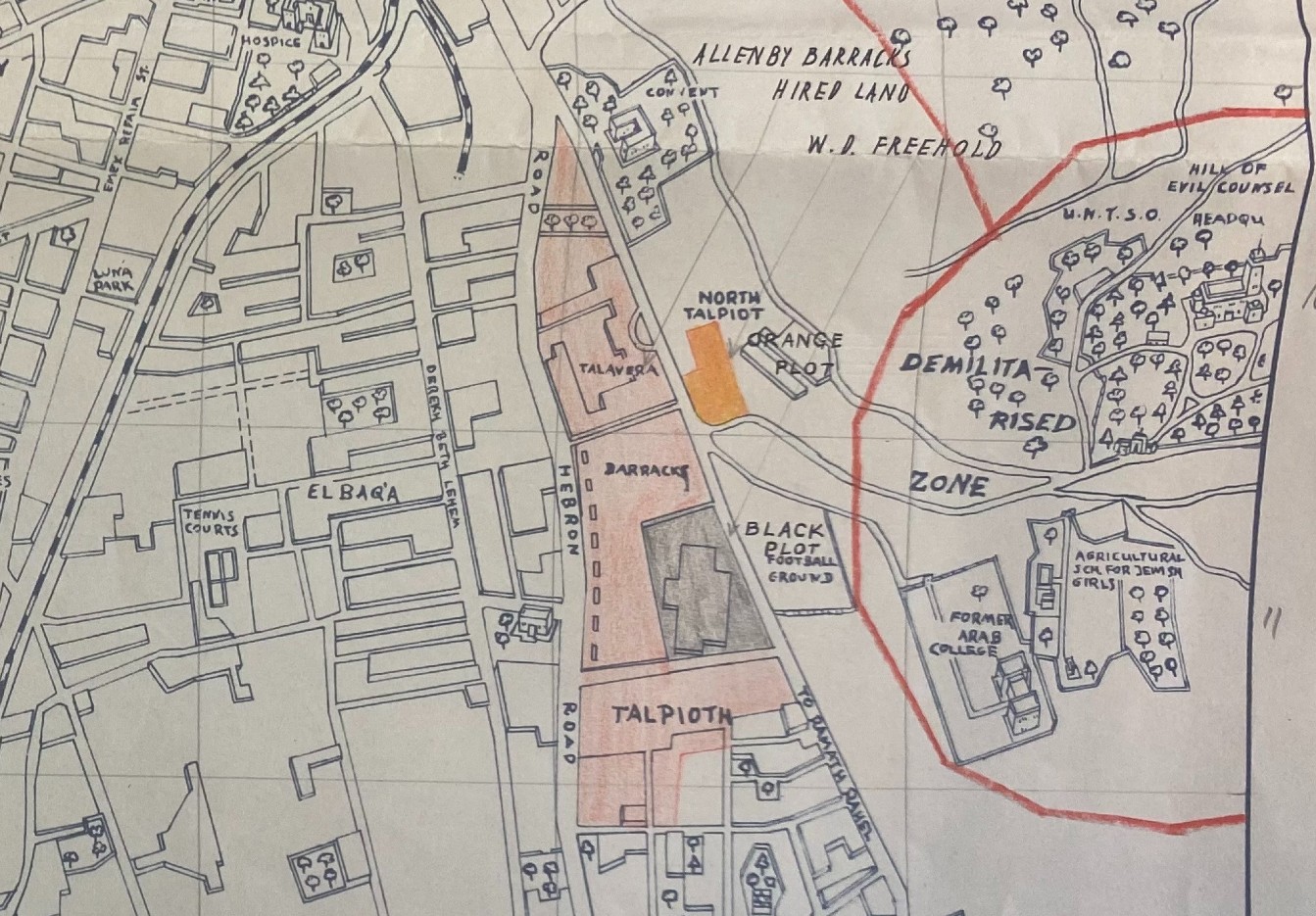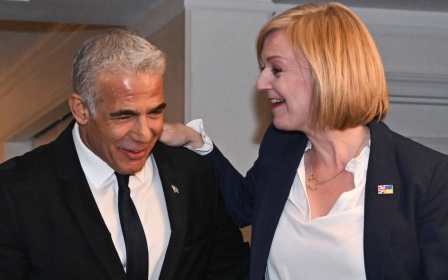Exclusive: The Jerusalem plot held by the UK as future site of embassy in Israel

The British government holds a plot of land in Jerusalem earmarked for decades as the site of a future embassy in Israel, Middle East Eye can exclusively reveal.
The site in the Talpiot neighbourhood, known as the Orange Plot, was retained by the British government as part of a 1960s agreement transferring ownership to the Israeli government of other assets acquired during the Palestinian Mandate.
Under the terms of that deal, the UK government agreed to lease the plot to the Israeli government for a sum of £1 a year - with the option to terminate the lease and reclaim the land for its own use at any time.
'The Israelis assume... that we wish to use the site in the event of our transferring the embassy from Tel Aviv to Jerusalem'
- Alan Goodison, Foreign and Commonwealth Office official
“The Israelis assume, no doubt, that we wish to use the site in the event of our transferring the Embassy from Tel Aviv to Jerusalem,” Alan Goodison, a Foreign and Commonwealth Office official wrote in July 1964.
“This is, of course, true.”
Stay informed with MEE's newsletters
Sign up to get the latest alerts, insights and analysis, starting with Turkey Unpacked
According to Israeli land records uncovered by MEE, the lease was renewed for 40 years in 2007. The records identify the owner of the land as the “Secretary of state for foreign and Commonwealth affairs of Great Britain and Northern Ireland”.
The undeveloped 6,950 square-metre site is in the area of the former Allenby Barracks, a British Army base dating from the Mandate era between 1920 and the creation of Israel in 1948.
MEE visited the plot on Monday. The area is empty scrubland apart from a few trees, sitting between Hanoch Albek Street and Shmeul Lupo Street in Jerusalem’s southeastern Talpiot neighbourhood.
It is adjacent to a proposed site for a new US embassy which is also on land previously held by the British, and appears to lie partially on the 1949 armistice line, known as the Green Line, separating Israel from the Palestinian territories of East Jerusalem and the West Bank.
Middle East Eye’s discoveries - based on a review of archival documents and land records in the UK and Israel - come after British Prime Minister Liz Truss pledged last month to review the current location of the UK embassy to Israel in Tel Aviv, prompting proponents for the embassy’s relocation to Jerusalem to suggest that the UK government had a plot of land ready to go.
Such a move would reverse decades of UK policy in line with international convention which holds that Jerusalem’s status should only be decided following final negotiations between the Israelis and Palestinians, and that moving the embassy would be de facto recognition that the city was Israel’s capital.
Truss’s review has been widely condemned, including from within her own Conservative Party. Former foreign secretary William Hague said moving the embassy would align the government with Donald Trump, while religious leaders in the UK, including Archbishop of Canterbury Justin Welby, have expressed concern.
In Jerusalem, senior Muslim leaders including the leaders of the Islamic Waqf, have written to the UK’s King Charles to warn that moving the embassy would inflame an “already unstable situation in Jerusalem”.
But MEE’s review of UK government documents held in the National Archives reveals that British officials were discussing potential sites for an embassy to Israel on UK-held land in Jerusalem from the 1950s.
In 1965, after more than a decade of negotiations with the Israeli government, the UK government sold the majority of the remaining Allenby Barracks land to the Israeli government for £140,000, according to an agreement signed in London.
But the UK held onto the “Orange Plot” and, as part of the same agreement, leased the property for £1 annually to Israel for 40 years. The lease was backdated to start on 15 May 1948, the day after the British Mandate ended.
Terms of the deal give Britain the option to end the lease agreement and reclaim the land to use for a “non-commercial purpose” at any time.
At that point, the Israeli government must either release the site for the UK government’s use within a year, or provide an alternative site “considered suitable by both parties for the particular use for which it is required”.
While the agreement never mentions an embassy, confidential notes exchanged between Foreign Office officials ahead of its signing make its purpose clear.
'A possible future embassy'
In July 1964, Hubert Pullar, the British Consul-General in Jerusalem, wrote to London to ask whether the Israelis, who were then visiting the UK for talks with British officials, “had been given to understand in any way that the [Orange] Plot was being retained as a possible future embassy?”
“I am not sure exactly how well the Israelis understand our intentions vis-a-vis the “Orange” plot, but it is most probable that they have guessed our main object of retaining the site for use in the event of moving the embassy to Jerusalem,” TJ Clark, an FCO official, scribbled by hand on the file containing Pullar’s letter.
“The secondary object - of retaining it for use in the event of Jerusalem becoming internationalised de facto - is presumably not one which they give any thoughts.”
One former British embassy official in Israel later described being tasked with visiting the land once a year to maintain the UK government's right of title, according to an oral history documented by the Churchill Archives Centre.
Timothy Dowse, first secretary and press officer at the embassy in Tel Aviv from 1983 to 1986 recalled: “We had a plot of land in Jerusalem, known as the Orange Plot because it had some orange trees on it, which was reserved for the day when the embassy could move to Jerusalem after a peace settlement.
“One of my jobs was to enter upon this land once a year to maintain our right of title to it. There was quite a large file of paperwork on the subject of the Orange Plot.”
The revelation of the UK's ownership of the land - and long-held intentions for the property - will raise questions for Palestinians who owned property which they leased to the British Mandate authorities who established the barracks.
Following the 1948 war, the property owners became refugees and their land was confiscated by Israeli authorities under its absentee property laws.
That land includes the property now slated to house a new US diplomatic compound, following President Donald Trump's decision to move the US embassy to Jerusalem in 2016.
Earlier this year, families of the landowners demanded that the US cancel its plans and return their land which is a short walk from the Orange Plot.
MEE asked the Foreign Office whether the Orange Plot remains the intended location of a future embassy. The Foreign Office declined to comment, citing Truss' ongoing review.
MEE's Lubna Masarwa in Jerusalem contributed to this story.
Middle East Eye delivers independent and unrivalled coverage and analysis of the Middle East, North Africa and beyond. To learn more about republishing this content and the associated fees, please fill out this form. More about MEE can be found here.







